Art Fairs
‘Now It’s Just the Real People’: Art Basel Opens Its First Fair in 18 Months With an Among-Friends Vibe (and Steady Sales, Too)
There was nary an American collector in sight.
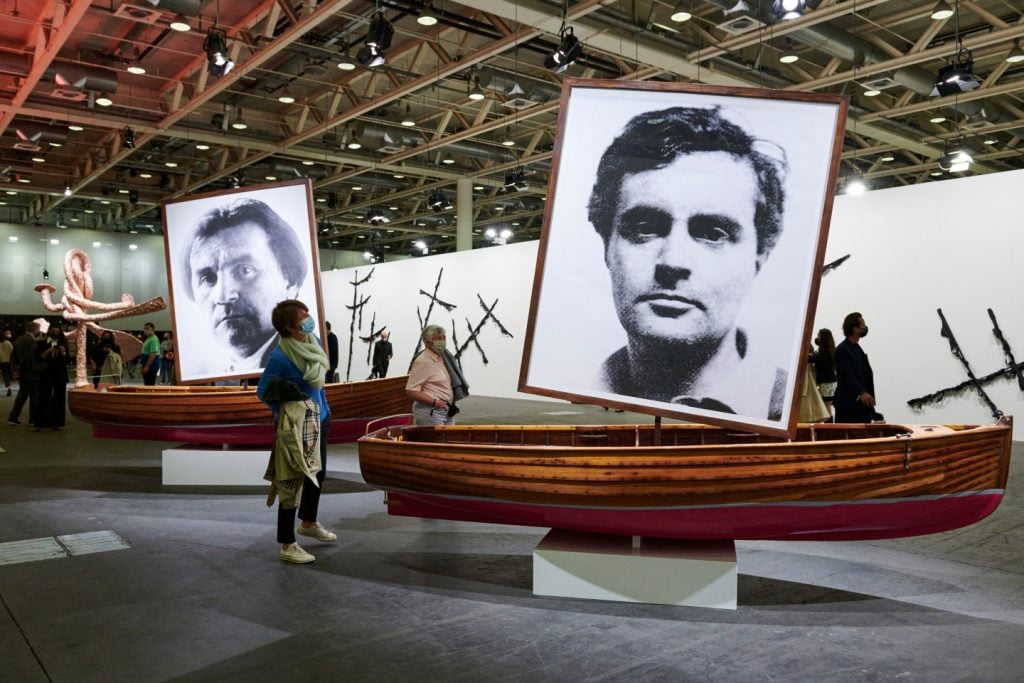
There was nary an American collector in sight.

Eileen Kinsella &
Naomi Rea

Collectors gathered at the Messe Basel this morning for the first VIP preview of Art Basel, the world’s most elite contemporary art fair, in 18 months. In any normal year, they would have lined up for a champagne breakfast while air-kissing fellow globe-trotters. This year, they were funneled through a large grey tent labeled “COVID Certification Center.” It was a clear sign of the changed—and strange—times we’re living in.
When the doors officially opened at 11 a.m., there was one major missing component: American collectors. “Most of our American collectors canceled last minute,” said Los Angeles gallerist Susanne Vielmetter. “So that put a little bit of anxiety in it.” By the end of the day, many observers agreed that the absence of American clients contributed to a more leisurely—dare we say civilized—atmosphere.
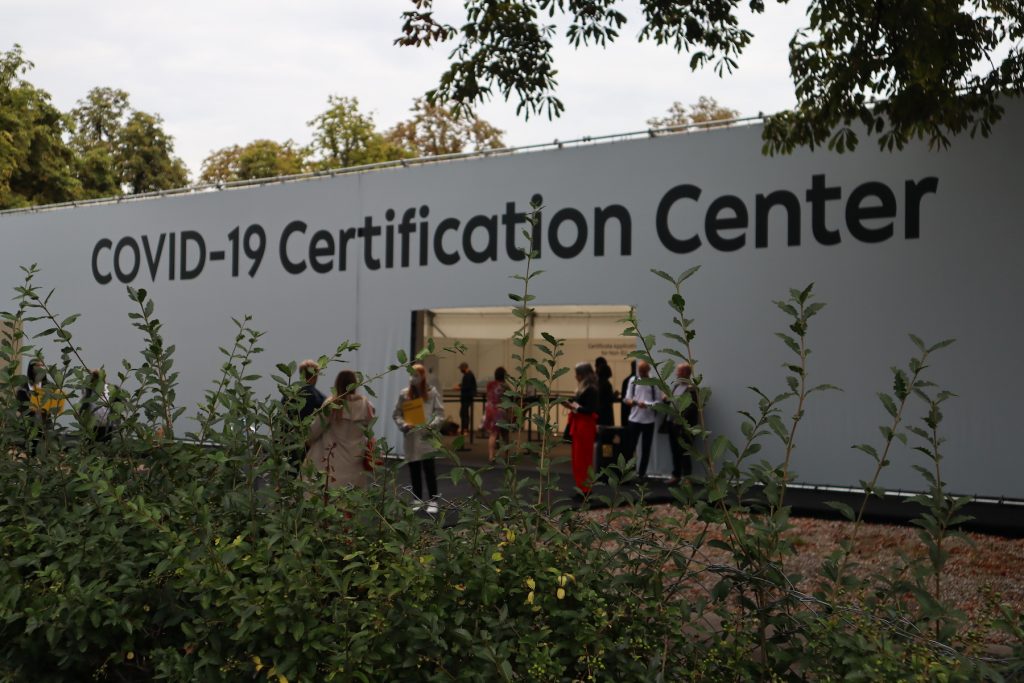
Art Basel’s entry. Photo by Naomi Rea.
European collectors spotted roaming the aisles on preview day included Guillaume Houzé, Walter Vanhaerents, Füsun Eczacıbaşı, Francesco Taurisano, and Anita Zabludowicz.
“It certainly doesn’t look like the first hours of the opening of Art Basel, but that doesn’t necessarily mean that [dealers] aren’t going to do the same business,” said art advisor Eva Ruiz. “There were a lot of previews and a lot of works sold before the fair.”
Indeed, early sales were strong for dealers offering prime work by brand names. Gladstone sold a Keith Haring painting with an asking price of $5.2 million, while Hauser & Wirth sold a 1975 Philip Guston painting for $6.5 million and Thaddaeus Ropac placed a Robert Rauschenberg work in the Unlimited sector for $4.5 million with a European museum.
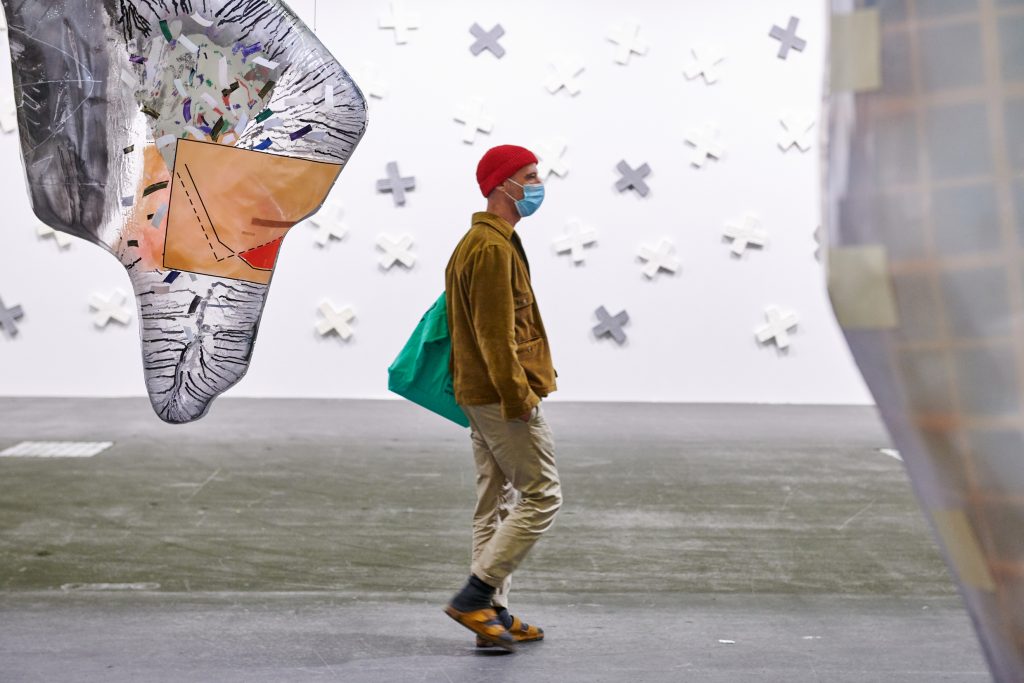
Art Basel in Basel 2021. ©Art Basel.
With notable exceptions including Richard and Pamela Kramlich, Craig Robins, and Jorge Pérez, American collectors largely opted out. But American dealers were more motivated to show.
“We need to do this fair and even in a year of great uncertainty as to who is going to come, and what it’s going to be like, the Basel fairs are really my priority, so it was not even a question, we had to do it,” said the San Francisco-based gallerist Jessica Silverman.
In the solo-project-focused Statements section, Silverman presented work by Rose B. Simpson, a Native American artist from Santa Clara Pueblo in Sante Fe, New Mexico. By the end of the preview, the dealer had sold seven out of 10 Simpson works for prices ranging from $20,000 to $50,000.
Art advisor Wendy Cromwell and several of her clients were among the Americans who didn’t make it. Just days before the fair, Cromwell reluctantly called off her trip after her airline carrier cancelled her flights. Still, she remained hard at work remotely. “I’ve been productive from PDFs,” she said. “I actually lost out on a few good things—access is as tight as ever for certain artists.”
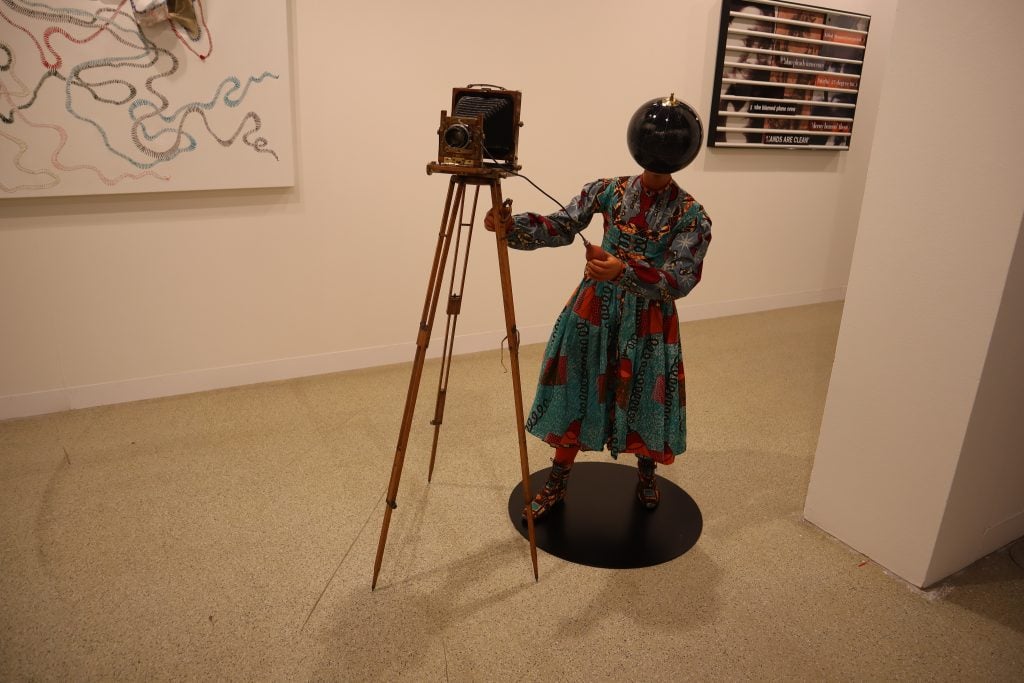
A work by Yinka Shonibare at Art Basel 2021. Photo: Naomi Rea.
A testament to the climate of uncertainty, pre-sales were a strong theme. “We had a lot of pre-sales on the digital from people who couldn’t fly out,” said Paris-based dealer Kamel Mennour. “But we have also sold physically in the first two hours to European collectors.” The gallery parted with work by mid-career artists Alicja Kwade and Camille Henrot as well as examples by late masters Yves Klein and Zao Wou-Ki at prices ranging from €200,000 to €5 million ($234,530 to $5.9 million).
The owner of South Africa’s Goodman Gallery, Liza Essers, was at the fair after 18 months of serious lockdown in Johannesburg. Given the slow rollout of immunizations in South Africa, she had been fully vaccinated for just four weeks, and said it felt “miraculous” to be allowed into Switzerland when the U.K. and the U.S. still have prohibitive restrictions on travel.
Her gallery, like many in the Global South, has been very isolated from the international art market during the pandemic (though it had the benefit of a London branch and a Hamptons summer pop-up). “I’m personally finding it a little bit daunting just because I really haven’t socialized or been out of my house for 18 months,” Essers said. “I know that in Europe, people have been out in restaurants but it’s very weird for me.”
The gallerist said the pace of sales was slower than in previous years, but she relished the opportunity to engage more deeply with collectors from Europe and beyond. She sold a William Kentridge to a European collector for $600,000, a Nicholas Hlobo to a Chinese museum for $150,000, and a Pamela Phatsimo Sunstrum to a Malaysian collector for $50,000. (The latter client was not physically present at the fair.)
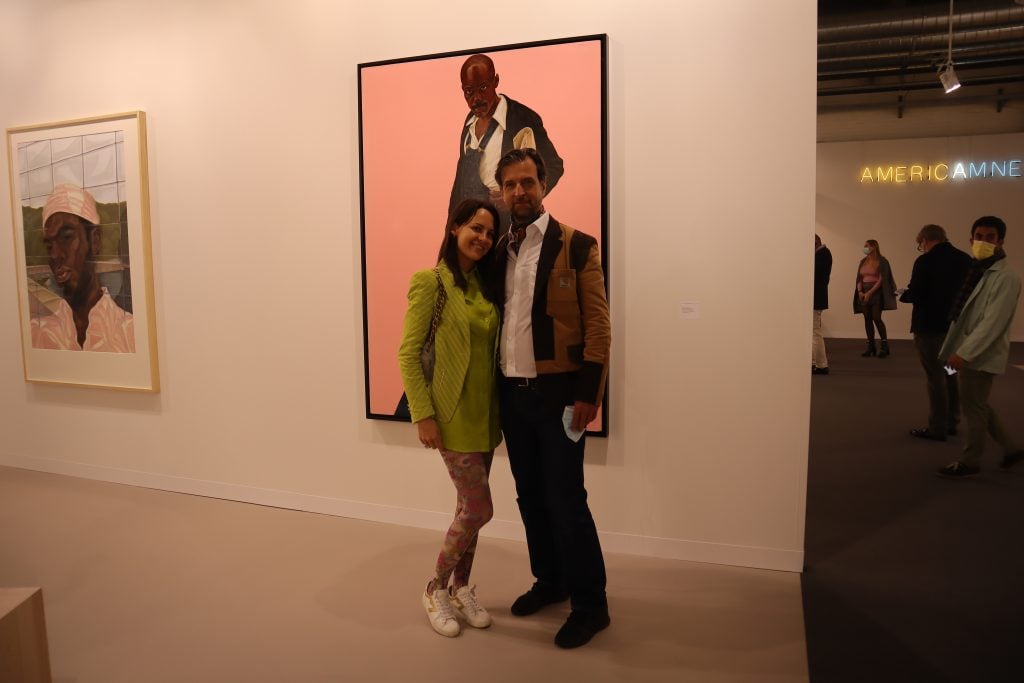
Eva Ruiz and Alain Servais. Photo by Naomi Rea.
Some collectors were also getting used to being back in the art circus. “I can’t imagine doing the rounds of all the booths, which I did for 15 years, but now it seems too big,” Belgian collector Alain Servais said. “We got used to the smaller set up [of regional fairs] so it’s a challenge to be faced again with 270 booths.” He added that his trajectory was further slowed by greeting old friends, which contributed to an overall sense of a “school reunion.”
Servais picked up a work by Nils Alix-Tabeling from Piktogram gallery at Liste and was sorely tempted by a $3.5 million Cady Noland “masterpiece” at Jeffrey Deitch’s Art Basel booth.
“In previous years, there were so many ‘first choice’ VIPs here in order to create an artificial sense of crowd to make you buy faster,” Servais said. “Now it’s just the real people who are interested. We have fewer Americans, which means we can have more discussions because, as you know, the Americans are just asking for prices and then they do a deal.”
The smaller crowd may have fostered a more relaxed, European mode of buying, but business was still done at a steady clip. Pace reported more than 20 sales in the first three hours, with most of the demand coming from European collectors and primary-market works by living artists.
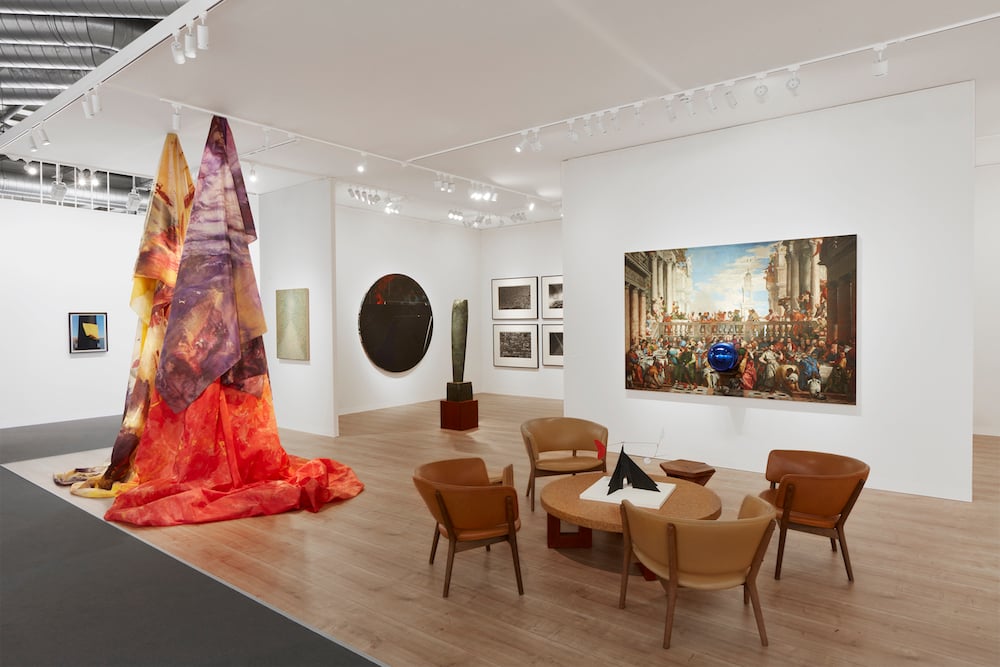
Installation view of Pace Gallery at Art Basel, September 2021. Image courtesy Pace Gallery
Highlights included a Jeff Koons gazing ball from 2021 for around $2 million; a sculpture by Barbara Hepworth for $1.2 million; and six drawings by new recruit Robert Longo for $90,000 each. By midday, Kasmin had sold six early charcoals by Lee Krasner, priced at $150,000 each, and Lehmann Maupin reported a nearly sold-out booth.
Thaddaeus Ropac sold work by Miquel Barceló, Lee Bul, Valie Export, Robert Longo, and Daniel Richter, while Hauser & Wirth parted with pieces by Frank Bowling, Louise Bourgeois, Nicolas Party, and others. By early afternoon, Perrotin had also placed the majority of its booth, including work by Maurizio Cattelan, Tavares Strachan, and Daniel Arsham. Lévy Gorvy sold work by Alexander Calder, Ellsworth Kelly, and Mickalene Thomas for prices up to $5 million.
Even with seven-figure sales, it was clear that consideration was the name of the game this year—proving yet again that the post-lockdown art market is far from a carbon copy of mid-2010s boom times. “The collectors who were able to attend,” Dominique Lévy said, “really took their time to have meaningful conversations.”